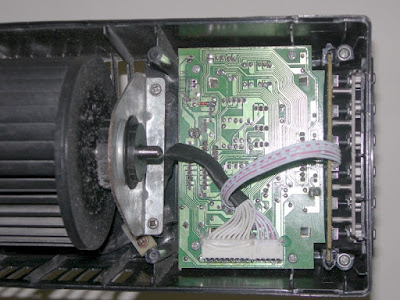Time for another fan repair post.
Unlike
the last episode, this one is a used tower fan - Origo Crudus, also known as FTF36-LED. The fan has 3 speeds, sleep timer, natural rhythmic wind function, etc. One can control it through an infrared remote control, but unfortunately the remote is missing.
The original owner said the fan doesn't work; sometimes the fan will refuse to start. Since the price was real cheap, and, given the symptoms, I'm confident that I can fix it, I bought it for a learning experience.

The first thing I did to it was cleaning. The picture above was taken after hours of vacuuming and sanitizing.
As I powered it on for the first time under my ownership, there was no response except a temperature display:

Perhaps I am optimistic... this is a good sign, as this means the brains (likely a micro-controller) behind everything is working fine.
Before I continue, here is a friendly
WARNING to viewers who wishes to try repairing their home appliances. Please read the disclaimer on this website.
Most home appliances run on line voltage that can serious hurt or kill you. ALWAYS disconnect power before working on the appliance. My fan was unplugged during the whole repair process. If the appliance you need to work on is permanently attached to a connection unit on the wall (e.g. bathroom extractor fan), you have to switch off the power at the circuit breaker first. You should then confirm that the power is indeed off at the connection unit, as it's always possible to switch off the wrong breaker. As always,
do NOT attempt the repair unless you absolutely 100% understand what you are doing and what the risks are.
Lets go right in. The following are close-up shots:


This is a 36" tower fan. A LED display and a few push buttons are at the top section, while the fan motor and the oscillation motor are at the base section. A long multi-conductor cable connects these two sections together.
Interestingly, the power supply board, which provides low voltage for the micro-controller, LEDs,
TRIACs, and all other electronics, is located at the base section behind the fan motor.
Like
the last fan repair scenario, a faulty power supply (due to bad capacitors) was the first thing on my mind. Lets inspect that:

The 1.2 uF CBB61 capacitor on the left is for the fan motor. The large and yellow 2 uF capacitor is a critical component at the beginning section of the non-isolated capacitive power supply. There are five
TRIACs to enable the micro-controller to interface with mains voltage control. A very common design.
Learning from experience, I removed the two yellow capacitors for testing:

The ones on the left are bad parts, right are replacements. It is hard to imagine how far off the capacitance values are!
CG-Elec X2 0.1 uF = 0.405 micro-farad (less than 50% of spec.)
CG-Elec X2 2.0 uF = 0.513 micro-farad (roughly 25% of spec.)
Tenta X2 0.1 uF = 0.104 micro-farad (looks good)
Epcos X2 2.2 uF = 1.95 micro-farad (within spec, as B32924 M-class has a tolerance of ± 20%)

Just like my last repair session, I used an
Epcos MKP X2 capacitor.

The soldering of the incoming AC wires were a mess, so I fixed those when I put the replacement capacitors in.
This should restore the right amount of power to all electronics, and conclude this exercise. Well, not really.
The fan would turn on (motor spins) when I press the power button. However, if I press the other buttons, like timer or speed, the fan would stop responding. Something tells me there are more problems with this fan. Time to look at the micro-controller circuitry:

The micro-controller is clearly labelled as "MCU1", right next to a buzzer. Noting the temperature display and the fan motor engagement, I know the micro-controller has to be fine. Otherwise, nothing would work.
What's left are the push-buttons:

A quick probing with a multimeter in continuity mode showed that all but two are bad - contact sticking when after being depressed.
This explains the non-responding controls. When buttons are stuck enabled, the micro-controller isn't expecting such situation to happen, thus simply hangs.

The old tactile switches are somehow rusty. This seemed really odd, as the switches are mounted internally, away from the elements like moisture.
I bought a pack of five new switches, so I had to reuse one that is still working.

After replacing the switches, the fan is in full working order.

After observing the fan operating for a few days, I am pleased to see that the repair is a success.



































